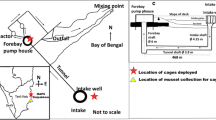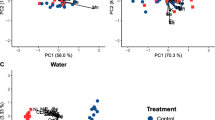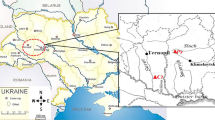Abstract
Stress responses in blue mussels (Mytilus edulis. L.) exposed to rganic pollutants were measured using several physiological measures and as changes in protein expression. Blue mussels from the Baltic Sea were exposed for 6 days in a flow-through system to two fractions of extracted Baltic sediments (containing primarily PAHs or PCBs) from one industrially impacted site and one off-shore site. Exposure to Aroclor1248 (a commercial PCB mixture) was included as a reference treatment. Physiological response was measured as changes in respiration, excretion, clearance rates and scope for growth. Of the physiological responses, only clearance rate and scope for growth in the Aroclor and impacted site PCB treatments differed significantly (p<0.05) from control organisms, perhaps due to a large variation among individuals. Seven proteins were observed, presumed to be from stress protein families (hsp60, hsp70 and hsp90) on one-dimensional electrophoresis gels. All protein levels, except three proteins, 62, 73 and 90 kDa, in response to PCB exposure from the industrial site, were significantly higher (p<0.05) in treated than in control organisms, suggesting the use of stress-inducible proteins as diagnostics in risk assessment. A wider sample of proteins was observed using two-dimensional gel electrophoresis. The presence or absence of protein spots compared to control organisms was used as an indication of stress. Between 23 and 76 proteins or spots were present and 15 to 23 absent compared to controls, and the results supported the physiological and one-dimensional gel results, suggesting that the mussels were indeed suffering from stress. The methods used here represent stress monitoring at two different levels of biological organization; the cellular- and the level of individual organisms. In this experiment the protein response showed less variation among individuals compared to the physiological parameters. The protein response, however, still suffers from the lack of interpretation into commonly used monitoring terms, which emphasizes the need for more knowledge of whether the response is a momentary reflection of exposure or an early warning of higher order effects.
Similar content being viewed by others
References
Axelman, J., C. Näf, C. Bandh, R. Ishaq, H. Pettersen, Y., Zebühr & D. Broman, 1997. Dynamics and distribution of hydrophobic organic compounds in the Baltic Sea. In Biological, Physico-Chemical and Biogeochemical Dynamics of Hydrophobic Organic Compounds, Ph. D. Thesis., Department of Zoology, Stockholm University, Stockholm.
Bandh, C., R. Ishaq, D. Broman, C. Näf, Y. Rönquist-Nii & Y. Zebühr, 1996. Separation of subsequent analysis of PCBs, PCDD/Fs and PAHs according to aromaticity and planarity using a two-dimensional HPLC system. Environmental Scientific Technology 30: 214–219.
Baumard, P., H. Budzinski & P. Garrigues, 1998a. PAHs in Arcachon Bay, France: Origin and biomonitoring with caged organisms. Maritime Pollution Bulletin 36: 577–586.
Baumard, P., H. Budzinski, P. Garrigues, J. C. Sorbe, T. Burgeot & J. Bellocq, 1998b. Concentrations of PAHs (Polycyclic aromatic hydrocarbons) in various marine organisms in relation to those in sediments and to trophic level. Maritime Pollution Bulletin 36: 951–960.
Björk, M. & M. Gilek, 1997. Bioaccumulation kinetics of PCB 31, 49 and 153 in the blue mussel, Mytilus edulis L. as a function of algal food concentration. Aquatic Toxicology 56: 151–158.
Björk, M. & M. Gilek, 1999. Efficiencies of polychlorinated biphenyl assimilation from water and algae food by the blue mussel (Mytilus edulis). Environmental Toxicology Chemistry 18: 765–771.
Blackstock, W. P. & M. P. Weir, 1999. Proteomics: quantitative and physical mapping of cellular proteins. Trends in Biotechnology 17: 121–127.
Bradford, M. B., 1976. A rapid and sensitive method for the quantitation of microgram quantities of protein utilizing the principle of protein-dye binding. Analytic Biochemistry 72: 248–254.
Bradley, B. P., 1993. Are the stress proteins indicators of Exposure or Effect? Marine Environment Research 35: 85–88.
Bradley, B. P. & J. B. Ward, 1989. Detection of major stress protein using a peptide antibody. Marine Environment Research 28: 471–475.
Bradley, B. P., C. M. Gonzalez, J.-A. Bond & B. E. Tepper, 1994. Complex mixture analysis using protein expression as a qualitative and quantitative tool. Environtal Toxicology Chemistry 13: 1043–1050.
Broman, D., C. Näf, C. Rolff & Y. Zebühr, 1991. Occurrence and dynamics of polychlorinated dibenzo-p-dioxins and dibenzofurans and polycyclic aromatic hydrocarbons in the mixed surface layer of remote coastal offshore waters of the Baltic. Environtal Scientific Technology 25: 1850–1864.
Broman, D., C. Näf, J. Axelman & H. Pettersen, 1994. Time trend analysis of PAHs and PCBs in the northern Baltic proper. Chemosphere 29: 1325–1331.
Chapple, J. P., G. R. Smerdon, R. J. Berry & A. J. S. Hawkins, 1998. Seasonal changes in stress-70 levels reflect thermal tolerance in the marine bivalve Mytilus edulis. Journal of Experimental Marine Biology and Ecology 229: 53–68.
Clayton, M. E., R. Steinmann, & K. Fent, 2000. Different expression patterns of heat shock proteins hsp60 and hsp70 in zebra mussels (Dreissena polymorpha) exposed to copper and tributyltin. Aquatic Toxicology 47: 213–226.
Conover, R. J., 1966. Assimilation of organic matter by zooplankton, Limnology and Oceanography 11: 338–354.
Ellis, R. J., 1987. Proteins as molecular chaperones. Nature 328: 378–379.
Ellis, R. J., 1999. Molecular chaperones;pathways and networks. Current Biology 9: 137–139.
Engwall, M., D. Broman, C. Näf, Y. Zebühr & B. Brunström, 1997. Dioxin-like compounds in HPLC-fractionated extracts of marine samples from the east and west coast of Sweden: Bioassayand instrumentally-derived TCDD equivalents. Marine Pollution Bulletin 34: 1032–1040.
Gilek, M., M. Tedengren & N. Kautsky, 1992. Physiological performance and general histology of the blue mussel, Mytilus edulis L., from the Baltic and North Seas. Netherland Journal of Sea Research 30: 11–21.
Gilek, M., M. Björk & C. Näf, 1996. Influence of body size on the uptake, depuration and bioaccumulation of polychlorinated biphenyl congeners by Baltic Sea blue mussels, Mytilus edulis. Marine Biology 1215: 499–510.
Guttman, S. D., C. V. C. Glover, C. D. Allis & M. A. Gorovsky, 1980. Heat Shock, deciliation and release from anoxia induce the synthesis of the same set of polypeptides in starved T. pyriformis. Cell 22: 299–307.
Hawker, D. W. & D. W. Connell, 1988. Octanol-water partition coefficients of polychlorinated biphenyl congeners. Environmental Scientific Technology 22: 382–387.
Hochachka, P. W. & G. W. Somero, 1984. Biochemical Adaptation. Princeton University Press, Princeton.
Hightower, L. E., C. E. Norris, P. J. Dilorio & E. Fielding, 1999. Heat shock responses of closely related species of tropical and desert fish. Am. Zool. 39: 877–888.
Hofmann, G. E., 1999. Ecologically relevant variation in induction and function of heat shock proteins in marine organisms. Am. Zool. 39: 889–900.
Håkanson, L., P. Jonsson, B. Jonsson & K. Martinsen, 1988. Distribution of chlorinated organic substances from pulp mills. Wat. Sci. Tech. 20: 25–36.
Kautsky, N., 1982. Growth and size structure in a Baltic Mytilus edulis population. Mar. Biol. 68: 117–133.
Kautsky, N., K. Johannesson & M. Tedengren, 1990. Genotypic and pheontypic differences between Baltic and North Sea population of Mytilus edulis evaluated through reciprocal transplantations. I. Growth and morphology. Mar. Ecol. Prog. Ser. 59: 203–210.
Koehn, R. K. & B. B. Bayne, 1989. Towards a physiological and genetical understanding of the energetics of the stress response. Biol. J. Linn. Soc. 37: 157–171.
Krebs, R. A. & V. Loeschke, 1994. Costs and benefits of activation of the heat shock response in Drosophila melanogaster. Func. Ecol. 8: 730–737.
Laemmli, U. K., 1970. Cleavage of structural proteins during the assembly of the head of bacteriophage T4. Nature 227: 680–685.
Leppäkoski, E. & E. Bonsdorff, 1989. Ecosystem variability and gradients. Examples from the Baltic Sea as a background for hazard assessment. In Landner, L. (ed.), Chemicals in the Aquatic Environment Advanced Hazard Assessment. Springer-Verlag, Berlin: 6–58.
Livingstone, D. R., 1985. Responses of the detoxication/ toxication enzyme systems of molluscs to organic pollutants and xenobiotics. Mar. Pollut. Bull. 16: 158–164.
Lundebye, A. K., W. J. Langston & M. H. Depledge, 1997. Stress proteins and condition index as biomarkers of tributyltin exposure and effect in mussels. Ecotox. 6: 127–136.
Olsson, B., J. L. Shepard, L. Zhou, B. P. Bradley & M. Tedengren. Exposure to reduced salinity, copper and a PCB causes similar induction patterns of proteins in three major stress protein families (hsp60, hsp70 and hsp90) in Baltic Sea mussels Mytilus edulis L. Submitted.
Roberts, D. A., G. E. Hofmann & G. N. Somero, 1997. Heat-shock protein expression in Mytilus californianus: acclimatization (seasonal and tidal-height comparisons) and acclimation effects.Biol. Bull. 192: 309–320.
Roberts, D. A., G. E. Hofmann & G. N. Somero, 1997. Heat-shock protein expression in Mytilus californianus: acclimatization (seasonal and tidal-height comparisons) and acclimation effects. Biol. Bull. 192: 309–320.
Sanders, B. M. 1993. Stress proteins in aquatic organisms: an environmental perspective. Crit. Rev. Tox. 23: 49–75.
Sanders, B. M. & L. S. Martin, 1991. Relationships between accumulation of a 60 kDa stress protein and scope-for-growth in Mytilus edulis exposed to a range of copper concentrations. Mar. Environ. Res. 31: 81–97.
Sanders, B. M. V. M. Pascoe, P. A. Nakagawa & L. S. Martin, 1992. Persistence of the heat-shock response over time in a common Mytilus mussel. Mol. Mar. Biol. Biotech. 1: 147–154.
Schroeder, H.C., R. Batel, H. M. A. Hassanein, S. Lauenroth, H.-St. Jenke, T. Simat, H. Steinhart & W. E. G. Müller, 2000. Correlation between the level of the potential biomarker, heat-shock protein, and the occurrence of DNA damage in the dab, Limanda limanda: a field study in the North Sea and the English Channel. Mar. Environ. Res. 49: 201–215.
Shepard, J. L. & B. P. Bradley, 2000. Protein expression signatures and lysosomal stability in Mytilus edulis exposed to graded copper concentrations. Mar. Environ. Res. 50: 457–463.
Shepard, J. L., B. Olsson, M. Tedengren & B. P. Bradley, 2000. Protein expression signatures identified in Mytilus edulis exposed to PCBs, copper and salinity stress. Mar. Environ. Res. 50: 337–340.
Somero, G. N., 1995. Proteins and temperature. Ann. Rev. Physiol. 57: 43–68.
Tedengren, M., B. Olsson, O. Reimer, D. C. Brown & B. P. Bradley, 1999a. Heat pretreatment increases cadmium resistance and hsp 70 levels in Baltic Sea mussels. Aquat. Tox. 48: 1–12.
Tedengren, M., B. Olsson, B. P. Bradley & L. Zhou, 1999b. Heavy metal uptake, physiological response and survival of the blue mussel (Mytilus edulis) from marine and brackish waters in relation to the induction of heat shock protein 70. Hydrobiologia 393: 261–269.
Werner, I., K. F. Kline & J. T. Hollibaugh, 1998. Stress protein in Ampelisca abdita (Amphipoda) exposed to sediments from San Francisco Bay. Mar. Environ. Res. 45: 417–430.
Wiens, M., C. Koziol, H. M. A. Hassanein, R. Batel, H. C. Schröder & W. E. G. Müller, 1998. Induction of gene expression of the chaperones 14-3-3 and hsp70 by PCB 118 (2,3',4,4',5-pentabiphenyl) in the marine sponge Geodia cydonium: novel biomarkers for polychlorinated biphenyls. Mar. Ecol. Prog. Ser. 165: 247–257.
Wilkins, M. R., J. C. Sanchez, K. L. Williams & D. F. Hochstrasser, 1996. Current challenges and future applications for protein maps and post-translational vector maps in proteome projects. Electrophoresis 17: 830–838.
Williams, K. L. & V. Pallini, 1997. Biological applications of proteomics. In Wilkins, M. R. Williams, K. L. Appel R. D., Hochstrasser, D. F. (eds), Proteome Research: New Frontiers in Functional Genomics. Springer-Verlag, Berlin.
Wulff F., L. Rahm, P. Jonsson, L. Brydsten, T. Ahl & Å. Granmo, 1993. A mass balance based model of chlorinated organic matter for the Baltic Sea-a challenge for ecotoxicology. Ambio 22: 27–31.
Author information
Authors and Affiliations
Rights and permissions
About this article
Cite this article
Olsson, B., Bradley, B.P., Gilek, M. et al. Physiological and proteomic responses in Mytilus edulis exposed to PCBs and PAHs extracted from Baltic Sea sediments. Hydrobiologia 514, 15–27 (2004). https://doi.org/10.1023/B:hydr.0000018203.90350.8e
Issue Date:
DOI: https://doi.org/10.1023/B:hydr.0000018203.90350.8e




